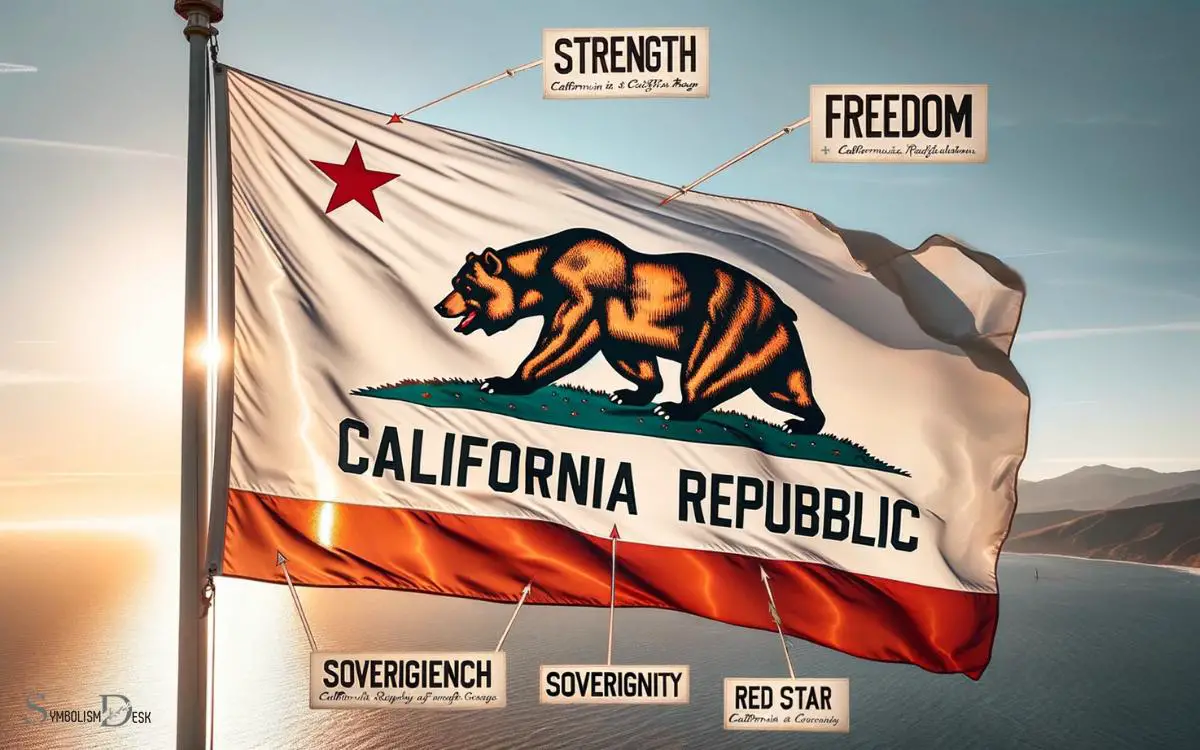What Do the Symbols on the California Flag Mean? History!
The symbols on the California flag, also known as the Bear Flag, represent the state’s historic struggle for independence, its incredible natural resources, and its relentless spirit of resistance and growth.
The most prominent symbols include the lone red star, the walking grizzly bear, and the words “CALIFORNIA REPUBLIC”.
The lone red star on the California flag is a nod to the Lone Star of Texas, recognizing the Californian settlers’ Texan origins.
The grizzly bear represents strength and resistance and is an emblem of the state’s rich wildlife. The phrase “CALIFORNIA REPUBLIC” signifies the brief period in 1846 when California was an independent nation before becoming a state in the United States.
The California flag is a vivid display of the state’s historical journey and its distinct identity.
The bold symbols of the lone red star, the grizzly bear, and the phrase “CALIFORNIA REPUBLIC” tell a story of strength, resistance, and independence, reflecting California’s spirit in the face of historic tribulations.
The flag is a proud emblem that carries the essence of California’s past, present, and future.
Key Takeaway
4 Symbols and Meanings of California Flag
| Symbol | Meaning |
|---|---|
| Bear | Represents strength and unyielding resistance. The specific bear used, a Grizzly Bear, is a native species to California. |
| Star | It’s a reference to the lone star of Texas, recognizing the fact that California, like Texas, was a lone republic. |
| Red Stripe | The red stripe symbolizes courage. |
| White Background | Represents purity. |

Historical Origins of the California Flag
The historical origins of the California flag can be traced back to the period of the California Republic in the mid-19th century. During this time, between 1846 and 1848, California existed as a sovereign state following a rebellion against Mexican rule.
The original flag of the California Republic, designed by William Todd, featured a red stripe, a star, and a grizzly bear. Although the republic was short-lived, its flag left a lasting legacy. In 1911, the original design was standardized as the official state flag of California.
The flag’s historical significance and connection to the state’s period of independence make it a powerful symbol for Californians, representing their heritage and the spirit of their state’s origins.
Now, let’s delve into the symbolism of the grizzly bear on the flag.
The Grizzly Bear Symbolism
The grizzly bear on the California flag symbolizes strength and resilience, reflecting the state’s rugged and independent spirit.
As California’s state animal, the grizzly bear holds historical significance, representing the wildlife that once thrived in the region.
Understanding the symbolism behind the grizzly bear offers insight into the values and heritage embedded in the design of the California flag.
Grizzly Bear Strength
The symbol of the grizzly bear on the California flag represents strength and resilience. The grizzly bear holds great significance, symbolizing various aspects that are deeply ingrained in the state’s history and identity.
The bear’s portrayal on the flag serves as a reminder of the following:
- Power: The grizzly bear is a formidable creature, embodying raw power and might.
- Adaptability: It symbolizes the ability to adapt to diverse environments and challenges.
- Independence: The bear’s solitary nature reflects independence and self-reliance.
- Endurance: Known for its stamina, the grizzly bear represents resilience in the face of adversity.
The grizzly bear’s symbolism encapsulates the enduring spirit of California, embodying the state’s strength and determination.
Moving forward to discuss California’s state animal…
California’s State Animal
Symbolizing strength and resilience, California’s state animal, the grizzly bear, holds significant historical and cultural importance.
The grizzly bear, once abundant in California, became a symbol of strength for Native American tribes, representing power, courage, and protection.
Spanish explorers named California ‘La California,’ possibly derived from the fictional Amazonian queen, Calafia, whose soldiers were said to be as fierce as grizzly bears.
When California was under Mexican rule, the bear flag revolt of 1846 further solidified the grizzly bear as a symbol of resistance and independence.
However, due to hunting and habitat destruction, the last known California grizzly bear was killed in 1922.
Despite its extinction, the grizzly bear remains a powerful emblem on the state flag, embodying California’s enduring spirit and untamed wilderness.
Historical Significance on Flag
With historical ties dating back to the bear flag revolt of 1846 and its representation in Native American cultures, the grizzly bear on the California flag holds significant historical significance as a symbol of resilience and independence.
The grizzly bear on the California flag symbolizes:
- Bear Flag Revolt: The bear represents the spirit of the Californian settlers who sought independence during the Bear Flag Revolt.
- Native American Symbolism: It reflects the reverence and significance of the grizzly bear in the culture and mythology of Native American tribes in California.
- State Identity: The bear embodies the ruggedness and strength of the state’s terrain and its people.
- Endangered Species: The bear also serves as a reminder of the state’s commitment to preserving its natural heritage, as the grizzly bear is now extinct in California.
Significance of the Red Star
The red star on the California flag holds significant symbolism and historical importance that is deeply rooted in the state’s cultural heritage.
Exploring the origins and meaning of the red star provides valuable insight into the historical and cultural representation on the flag.
Understanding the significance of the red star offers a glimpse into the rich tapestry of California’s history and the values it holds dear.
Red Star Symbolism
The red star on the California flag represents the state’s aspirations for a better future and its revolutionary history.
The symbolism of the red star is deeply rooted in California’s history and ideals, conveying several key messages:
- Hope for Progress: The red star symbolizes the state’s commitment to progress and improvement.
- Revolutionary Spirit: It represents California’s history of social and political change, reflecting the state’s revolutionary roots.
- Unity and Solidarity: The red star signifies the unity and solidarity of the people of California in their pursuit of common goals.
- Endurance and Resilience: It embodies the enduring spirit and resilience of Californians in the face of challenges and adversity.
Historical Significance Explained
A prominent symbol on the California flag, the red star holds significant historical significance, representing the state’s aspirations for progress and its enduring revolutionary spirit.
The red star on the flag of California has its roots in the California Lone Star Flag, which was flown during the 1846 Bear Flag Revolt. This revolt was a key event in California’s history, symbolizing the state’s struggle for independence and freedom.
The red color of the star is said to represent courage, while the five points of the star could signify qualities such as ambition, unity, and democratic ideals.
The star’s presence on the California flag serves as a reminder of the state’s rich history and its enduring commitment to progress and liberty.
Cultural Representation on Flag
Symbolizing the state’s revolutionary spirit, the red star on the California flag represents the aspirations for progress and freedom. The red star’s significance on the California flag goes beyond its aesthetic value. It serves to convey the cultural and historical importance of the state.
The red star is a powerful and enduring symbol, resonating with the following aspects:
- Revolutionary ideals and the spirit of change
- California’s role as a beacon of hope and progress
- Recognition of the state’s diverse and inclusive society
- Acknowledgment of the state’s historical and ongoing pursuit of equality and justice
These elements combined reflect the profound cultural representation embedded within the red star on the California flag, encapsulating the state’s ethos and values.
Evolution of the Flag Design
Three different designs of the California flag have been adopted since the state’s admission to the Union in 1850. The original flag, known as the ‘Bear Flag,’ was first raised during the Bear Flag Revolt of 1846, but it was never officially adopted.
In 1911, the current flag design was standardized, featuring a white field with a grizzly bear, a red star, and the words ‘California Republic.’ The bear symbolizes strength and unyielding resistance, while the lone red star represents opportunity and independence.
The flag’s evolution signifies the state’s rich history and the enduring spirit of its people. Despite the changes in design, the flag continues to serve as a powerful emblem of California’s identity and heritage.
Interpretation of ’California Republic
Representing the spirit of independence and self-governance, the phrase ‘California Republic’ on the state flag embodies the historical aspirations of Californians towards autonomy.
The interpretation of ‘California Republic’ can be understood through the following points:
- Bear Flag: The prominent image of a grizzly bear represents strength and independence.
- Red Stripe: Symbolizes courage and the willingness to fight for freedom.
- California Lone Star: Reflects the state’s individuality and uniqueness.
- ‘California Republic’ Text: Serves as a reminder of the brief period in 1846 when California declared itself a sovereign state before becoming part of the United States.
These elements collectively depict the historical and enduring desire of Californians for self-rule and independence.
Cultural Impact and Legacy
Having influenced art, literature, and popular culture, the symbols on the California flag have left a lasting cultural impact and legacy.
The bear and the star, iconic elements of the flag, have become powerful symbols representing the spirit of California. These symbols have been widely embraced in various forms of art, from paintings to sculptures, and have been featured in literature, becoming synonymous with the state’s identity.
This enduring influence has solidified the flag’s symbols as an integral part of California’s cultural heritage.
What Is the Meaning Behind the Symbols on the Maryland Flag?
The symbols on Maryland’s flag hold significant meanings. The flag features the yellow-and-black heraldic design of Lord Baltimore’s family and the red and white colors from the Calvert coat of arms. The quartered flag represents Maryland’s founding families the Calverts and Crosslands. The symbols on maryland flag meanings embody the state’s rich history and its founders’ heritage.
What Does the Symbolism on the California Flag Mean?
The symbols on South Carolina flag are not relevant when discussing the symbolism on the California flag. The California flag showcases a red star, a grizzly bear, and a California Republic banner, each representing significant elements in the state’s history. The bear signifies strength and protection, while the star represents sovereignty. The flag’s overall symbolism highlights the endurance and independence of California.
Controversies and Modern Perspectives
The interpretation and significance of the symbols on the California flag have sparked debates and raised modern perspectives on their historical implications. This has led to a reevaluation of the flag’s representation and its impact on various communities.
Controversies and modern perspectives surrounding the California flag include:
- Indigenous Representation: Some argue that the depiction of a California grizzly bear may not accurately represent the state’s indigenous cultures.
- Spanish Colonialism: The image of the grizzly bear has also been criticized for its association with the period of Spanish colonialism and its impact on Native American communities.
- Environmental Concerns: The depiction of the grizzly bear has raised discussions about the state’s conservation efforts and the significance of protecting wildlife.
- Inclusivity and Diversity: Modern perspectives emphasize the need for symbols that are inclusive and representative of California’s diverse population.
Conclusion
In conclusion, the symbols on the California flag hold historical significance and represent the state’s identity. Additionally, understanding flag symbols historically can provide valuable insight into the state’s past and the values it holds dear. The red star, for example, is a nod to California’s association with the Mexican flag, while the grizzly bear represents the state animal and embodies strength and resilience. Overall, the design of the California flag reflects the state’s rich heritage and serves as a source of pride for its residents.
The flag’s design has evolved over time, but the grizzly bear and the red star remain iconic symbols.
The California flag is one of the most recognizable state flags in the United States, with 72% of Californians being able to identify it. Its cultural impact and legacy continue to be celebrated and debated.






